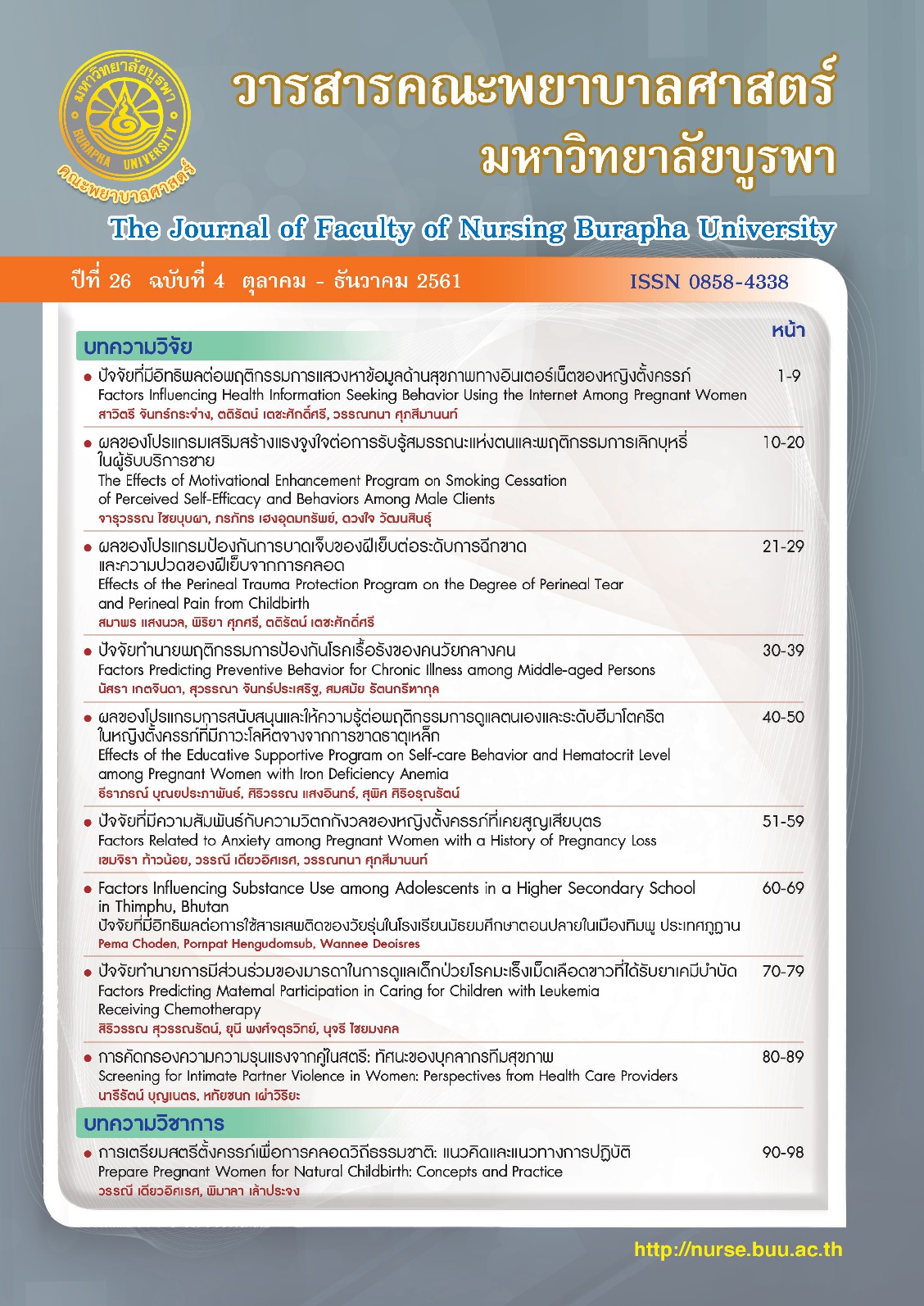ปัจจัยที่มีอิทธิพลต่อการใช้สารเสพติดของวัยรุ่นในโรงเรียนมัธยมศึกษาตอนปลายในเมืองทิมพู ประเทศภูฏาน
คำสำคัญ:
การใช้สารเสพติดในวัยรุ่น, การใช้สารเสพติดในครอบครัว, การใช้สารเสพติดในเพื่อน, ความสัมพันธ์กับเพื่อน, การรับรู้ความสามารถในการปฏิเสธการใช้สารเสพติด, ความมุ่งมั่นในการเรียนบทคัดย่อ
บทคัดย่อ
การวิจัยแบบความสัมพันธ์และทำนายนี้ มีวัตถุประสงค์เพื่อศึกษาการใช้สารเสพติดและปัจจัยทำนายการใช้สารเสพติดได้แก่ การใช้สารเสพติดในเพื่อน การใช้สารเสพติดและการมีพฤติกรรมที่ไม่เหมาะสมในครอบครัว การรับรู้ความสามารถในการปฏิเสธการใช้สารเสพติด ความสัมพันธ์กับเพื่อน ความมุ่งมั่นในการเรียน และ พฤติกรรมหุนหันพลันแล่น กลุ่มตัวอย่างเป็นนักเรียนเกรด 9 ถึง 12 ของโรงเรียนมัธยมศึกษาตอนปลายแห่งหนึ่งของเมืองทิมพู ประเทศภูฏานจำนวน 420 คน ได้มาโดยการสุ่มแบบหลายขั้นตอน เก็บข้อมูลโดยใช้ แบบสอบถามข้อมูลส่วนบุคคล แบบสำรวจการใช้สารเสพติดของเยาวชนในชุมชน แบบวัดการใช้สารเสพติดในเพื่อน แบบวัดความมั่นใจเกี่ยวกับการไม่ใช้สารเสพติด แบบวัดการใช้สารเสพติดและการมีพฤติกรรมที่ไม่เหมาะสมในครอบครัว แบบวัดความสัมพันธ์กับเพื่อน และ แบบวัดพฤติกรรมหุนหันพลันแล่นของ Barratt วิเคราะห์ข้อมูลโดยใช้สถิติเชิงพรรณนาและการถดถอยพหุคูณ
ผลการศึกษาพบว่าการใช้สารเสพติดของนักเรียนอยู่ในระดับปานกลาง (M=24.40, SD = 8.40) พบการใช้ ยาสูบ บุหรี่ และแอลกอฮอล์ มากที่สุด ผลการวิเคราะห์ถดถอยพหุคูณพบว่าปัจจัยที่ศึกษาสามารถร่วมกันทำนายความแปรปรวนของการใช้สารเสพติดได้ 66% (R2 = .66, F6, 413 = 131.74, p < .001) อิทธิพลของตัวแปรเรียงจากสูงไปต่ำคือ การใช้สารเสพติดในเพื่อน (β = 0.48) การรับรู้ความสามารถในการปฏิเสธการใช้สารเสพติด (β = -0.22) การใช้สารเสพติดและการมีพฤติกรรมที่ไม่เหมาะสมในครอบครัว (β = 0.14) ความมุ่งมั่นในการเรียน (β = -0.13) และความสัมพันธ์กับเพื่อน (β = -0.10) พฤติกรรมหุนหันพลันแล่นไม่พบมีอิทธิพล ผลการวิจัยทำให้ทราบถึงการใช้สารเสพติดและปัจจัยที่มีอิทธิพลต่อการใช้สารเสพติดในวัยรุ่นที่ศึกษา ในการป้องกันและลดการใช้สารเสพติดควรให้ความสำคัญกับปัจจัยที่มีอิทธิต่อการใช้สารเสพติด ได้แก่ การใช้สารเสพติดในเพื่อน การรับรู้ความสามารถในการปฏิเสธการใช้สารเสพติด การใช้สารเสพติดและการมีพฤติกรรมที่ไม่เหมาะสมในครอบครัว ความมุ่งมั่นในการเรียน และความสัมพันธ์กับเพื่อน
เอกสารอ้างอิง
Arthur, M. W., Hawkins, J. D., Pollard, J. A., Catalano, R. F., & Baglioni Jr, A. J. (2002). Measuring risk and protective factors for use, delinquency, and other adolescent problem behaviors: The Communities That Care Youth Survey. Evaluation Review, 26(6), 575-601
Bandura, A. (1984). Influence of gender constancy and social power on sex-linked modeling. Journal of Personality and Social Psychology, 47(6), 1292.
Bandura, A. (2001). Social cognitive theory: An agentic perspective. Annual Review of Psychology, 52(1), 1-26.
Casey, B. J., Jones, R. M., Levita, L., Libby, V., Pattwell, S. S., Ruberry, E. J & Somerville, L. H. (2010). The storm and stress of adolescence: insights from human imaging and mouse genetics. Developmental Psychobiology, 52(3), 225-235.
Cleveland, M.. J., Feinberg, M. E., Bontempo, D. E., & Greenberg, M. T. (2008). The role of risk and protective factors in substance use across adolescence. Journal of Adolescent Health, 43, 157–164.
Cox, R. (2014). Differential effects of parents and peers on externalizing behavior and drug Use. Acta de Investigación Psicológica, 4(2), 1491-1509.
Coyle, C., Bramham, J., Dundon, N., Moynihan, M., & Carr, A. (2016). Exploring the positive impact of peers on adolescent substance misuse. Journal of Child & Adolescent Substance Abuse, 25(2), 134-143.
Kadden, R. M., & Litt, M. D. (2011). The role of self-efficacy in the treatment of substance use disorders. Addictive Behaviors, 36(12), 1120-1126.
Karakos, H. L. (2014). Positive peer support or negative peer influence? The role of peers among adolescents in recovery high schools. Peabody Journal of Education, 89(2), 214-228.
Krejcie, R. V., & Morgan, D. W. (1970). Determining sample size for research activities. Educational and Psychological Measurement, 30(3), 607-610.
Myers, L. L. (2013). Substance use among rural African American adolescents: Identifying risk and protective factors. Child and Adolescent Social Work Journal, 30(1), 79-93.
Ohannessian, C. M. (2012). Discrepancies in adolescents' and their mothers' perceptions of the family and adolescent externalizing problems. Family Science, 3(2), 135-140.
Panda, S., Wangdi, C., Mukherjee, D., Chowdhury, L., Wangdi. S., & Pahari, S. (2009). National baseline assessment of drugs and controlled substance use in Bhutan-2009. United Nations Office on Drugs and Crime, New Delhi. Retrieved from https://www.unodc.org/documents/southasia/reports/National_Baseline_Assessment_of_Drugs_and_Controlled_Substance_use_in_Bhutan_2009.pdf.
Patton, J. H., & Stanford, M. S. (1995). Factor structure of the Barratt impulsiveness scale. Journal of Clinical Psychology, 51(6), 768-774.
Razali, M. M., & Kliewer, W. (2015). Risk and protective factors for recreational and hard drug use among Malaysian adolescents and young adults. Addictive Behaviors, 50, 149-156.
Tabtimthong, W., Junprasert, S., & Homsin, P. (2012). Effects of promoting self-Efficacy on
perceived self-Efficacy, outcome expectation and smoking avoidance behaviors of early male adolescents. The Journal of Faculty of Nursing, Burapha University.
20(1), 33-43. [In Thai]
United Nations International Children Emergency Fund. [UNICEF]. (2015). Protecting adolescents and youth in Bhutan from substance abuse. Retrieved from http://www.unicefbhutan.org.bt/ wp-content/ uploads/ 2015/ 10/ 7.-Protecting-Adolescent-and-Youth-in-Bhutan-from-Substance-Abuse.pdf
United Nations Office on Drugs and Crime. (2017). World drug report. Retrieved from https://www.unodc.org/easternafrica/en/world-drug-report-2017.html
Wang, M. T., & Fredricks, J. A. (2014). The reciprocal links between school engagement, youth problem behaviors, and school dropout during adolescence. Child Development, 85(2), 722-737.





